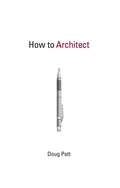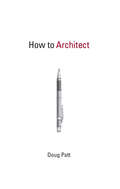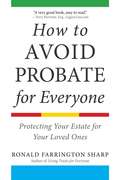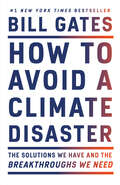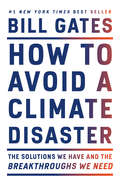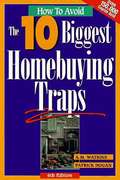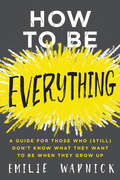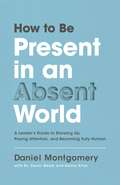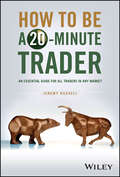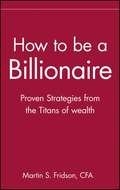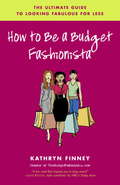- Table View
- List View
How to Appraise Your Organization's Capabilities and Disabilities
by Clayton M. ChristensenOrganizations, independent of the people and other resources in them, have capabilities. This chapter outlines three classes of factors that affect an organization's capabilities: resources, process, and values. The successful organization must develop or acquire the capability to embrace and respond successfully to change. This chapter was originally published as chapter 8 of "The Innovator's Dilemma: When New Technologies Cause Great Firms to Fail."
How to Architect
by Doug PattThe word "architect" is a noun, but Doug Patt uses it as a verb--coining a term and making a point about using parts of speech and parts of buildings in new ways. Changing the function of a word, or a room, can produce surprise and meaning. In How to Architect, Patt--an architect and the creator of a series of wildly popular online videos about architecture--presents the basics of architecture in A-Z form, starting with "A is for Asymmetry" (as seen in Chartres Cathedral and Frank Gehry), detouring through "N is for Narrative," and ending with "Z is for Zeal" (a quality that successful architects tend to have, even in fiction--see T he Fountainhead's architect-hero Howard Roark. ) How to Architect is a book to guide you on the road to architecture. If you are just starting on that journey or thinking about becoming an architect, it is a place to begin. If you are already an architect and want to remind yourself of what drew you to the profession, it is a book of affirmation. And if you are just curious about what goes into the design and construction of buildings, this book tells you how architects think. Patt introduces each entry with a hand-drawn letter, and accompanies the text with illustrations that illuminate the concept discussed: a fallen Humpty Dumpty illustrates the perils of fragile egos; photographs of an X-Acto knife and other hand tools remind us of architecture's nondigital origins. How to Architect offers encouragement to aspiring architects but also mounts a defense of architecture as a profession--by calling out a defiant verb: architect!
How to Architect
by Doug PattThe basics of the profession and practice of architecture, presented in illustrated A-Z form. The word "architect" is a noun, but Doug Patt uses it as a verb—coining a term and making a point about using parts of speech and parts of buildings in new ways. Changing the function of a word, or a room, can produce surprise and meaning. In How to Architect, Patt—an architect and the creator of a series of wildly popular online videos about architecture—presents the basics of architecture in A-Z form, starting with "A is for Asymmetry" (as seen in Chartres Cathedral and Frank Gehry), detouring through "N is for Narrative," and ending with "Z is for Zeal" (a quality that successful architects tend to have, even in fiction—see The Fountainhead's architect-hero Howard Roark.) How to Architect is a book to guide you on the road to architecture. If you are just starting on that journey or thinking about becoming an architect, it is a place to begin. If you are already an architect and want to remind yourself of what drew you to the profession, it is a book of affirmation. And if you are just curious about what goes into the design and construction of buildings, this book tells you how architects think. Patt introduces each entry with a hand-drawn letter, and accompanies the text with illustrations that illuminate the concept discussed: a fallen Humpty Dumpty illustrates the perils of fragile egos; photographs of an X-Acto knife and other hand tools remind us of architecture's nondigital origins. How to Architect offers encouragement to aspiring architects but also mounts a defense of architecture as a profession—by calling out a defiant verb: architect!
How to Avoid Commoditization
by Clayton M. Christensen Michael E. RaynorWhat causes commoditization, and is it the inevitable fate of all companies in competitive markets? Many executives believe that commoditization is the inevitable end-result, no matter how innovative their companies are. The purpose of this chapter is to help managers understand the reciprocal relationship between commoditization and de-commoditization so they can detect when and where they are beginning to happen. If managers understand how these processes work, they can steer their companies to where the money will be, not to profitable business models of the past.
How to Avoid Getting Lost in the Numbers
by David H. MaisterProvides some hints and tips to students who encounter difficulty in performing quantitative analyses of case studies. Describes how to approach the numbers and suggests devices they can use to overcome their problems.
How to Avoid Probate for Everyone: Protecting Your Estate for Your Loved Ones
by Ronald Farrington SharpLearn how to prepare your estate and avoid costly mistakesWant to avoid probate? Gleaned from his forty-four years as an estate attorney, Sharp describes the probate process and the many reasons why it should be your last resort in estate settlement methods in How to Avoid Probate for Everyone. Living trusts are important, but there are many alternatives to using a living trust for probate avoidance. These alternatives are explained step-by-step as Sharp delves into the details. Examples of such approaches include:While state laws vary, most allow for expedited procedures for low-value estates without having to create a trust.There are a dozen different ways of leaving assets to heirs automatically at death.Special types of deeds allow you to keep control of your real estate during lifetime yet transfer it to heirs automatically at death.There are several ways of titling vehicles that allow heirs to get them without court procedures.Beneficiary designations on bank and investment accounts keep them out of your probate estate.Joint ownership of accounts and real estate can solve inheritance problems.Common myths and misconceptions about estates and probate are debunked. Trusts are covered in detail, including a section on must-use trust provisions to cover common complications and showing how a trust can easily resolve these. Joint and single trusts are examined and issues, such as how to handle personal property items, are suggested. (For instance, who gets the piano?) By avoiding probate court-supervised adult guardianship and conservatorship, families can avoid embarrassing and time-consuming incompetency hearings in court. Samples of the described documents are also included to give the reader an idea of what the paperwork actually looks like. Sharp&’s matter-of-fact explanations will prepare any reader to take the necessary steps to prepare their estate with confidence and avoid probate.
How to Avoid a Climate Disaster: The Solutions We Have and the Breakthroughs We Need
by Bill GatesIn this urgent, singularly authoritative book, Bill Gates sets out a wide-ranging, practical--and accessible--plan for how the world can get to zero greenhouse gas emissions in time to avoid an irreversibleclimate catastrophe.Bill Gates has spent a decade investigating the causes and effects of climate change. With the help and guidance of experts in the fields of physics, chemistry, biology, engineering, political science and finance, he has focused on exactly what must be done in order to stop the planet's slide toward certain environmental disaster. In this book, he not only gathers together all the information we need to fully grasp how important it is that we work towardnet-zero emissions of greenhouse gases but also details exactly what we need to do to achieve this profoundly important goal. He gives us a clear-eyed description of the challenges we face. He describes the areas in which technology is already helping to reduce emissions; where and how the current technology can be made to function more effectively; where breakthrough technologies are needed, and who is working on these essential innovations. Finally, he lays out a concrete plan for achieving the goal of zero emissions--suggesting not only policies that governments should adopt, but what we as individuals can do to keep our government, our employers and ourselves accountable in this crucial enterprise.As Bill Gates makes clear, achieving zero emissions will not be simple or easy to do, but by following the guidelines he sets out here, it is a goal firmly within our reach.
How to Avoid a Climate Disaster: The Solutions We Have and the Breakthroughs We Need
by Bill GatesIn this urgent, authoritative book, Bill Gates sets out a wide-ranging, practical--and accessible--plan for how the world can get to zero greenhouse gas emissions in time to avoid a climate catastrophe. <P><P>Bill Gates has spent a decade investigating the causes and effects of climate change. With the help of experts in the fields of physics, chemistry, biology, engineering, political science, and finance, he has focused on what must be done in order to stop the planet's slide to certain environmental disaster. In this book, he not only explains why we need to work toward net-zero emissions of greenhouse gases, but also details what we need to do to achieve this profoundly important goal. <P><P>He gives us a clear-eyed description of the challenges we face. Drawing on his understanding of innovation and what it takes to get new ideas into the market, he describes the areas in which technology is already helping to reduce emissions, where and how the current technology can be made to function more effectively, where breakthrough technologies are needed, and who is working on these essential innovations. Finally, he lays out a concrete, practical plan for achieving the goal of zero emissions--suggesting not only policies that governments should adopt, but what we as individuals can do to keep our government, our employers, and ourselves accountable in this crucial enterprise. <P><P>As Bill Gates makes clear, achieving zero emissions will not be simple or easy to do, but if we follow the plan he sets out here, it is a goal firmly within our reach. <P><P><b>A New York Times Bestseller</b>
How to Avoid the Ten Biggest Home-Buying Traps
by Patrick Hogan A. M. WatkinsBuying a house can be a wonderful experience if you understand not only what to buy, but also what not to buy. But can you avoid common homebuying mistakes if you don't know what they are? Let How to Avoid the 10 Biggest Homebuying Traps guide you safely through the process of buying your home by showing you what pitfalls to identify and sidestep. With this guidance, you can successfully navigate potential money traps to find the home of your dreams. How To Avoid the 10 Biggest Homebuying Traps reveals the ten most common, and costly, mistakes homebuyers make. Guided by real estate expert Art Watkins, you'll learn how to spot and avoid: Houses that are overpriced for their value New construction by shady builders Homes that are marginal in quality Houses packed with special features for an impulse buy Garbled floor plans that reduce a home's value Homes that are expensive energy guzzlers, and much more.
How to Be Better at Almost Everything: Learn Anything Quickly, Stack Your Skills, Dominate
by Pat FlynnMastering one specific skill set might have been the key to success 20 years ago . . . but being the best at a single thing just doesn't cut it in today's global economy. Think about those people who somehow manage to be amazing at everything they do—the multimillionaire CEO with the bodybuilder physique or the rock star with legions of adoring fans. How do they manage to be so great at life? By acquiring and applying multiple skills to make themselves more valuable to others, they've become generalists, able to "stack" their varied skills for a unique competitive edge. In How to Be Better at Almost Everything, bestselling author, fitness expert, entrepreneur, and professional business coach Pat Flynn shares the secrets to learning (almost) every skill, from marketing and music to relationships and martial arts, teaching how to combine interests to achieve greatness in any field. Discover how to: Learn any skill with only an hour of practice a day through repetition and resistance Package all your passions into a single tool kit for success with skill stacking Turn those passions into paychecks by transforming yourself into a person of interest To really get ahead in today's fast-paced, constantly evolving world, you need a diverse portfolio of hidden talents you can pull from your back pocket at a moment's notice. The good news? You don't need to be a genius or a prodigy to get there—you just have to be willing to learn. How to Be Better at Almost Everything will teach you how to make your personal and professional goals a reality, starting today.
How to Be Bold: The Surprising Science of Everyday Courage
by Ranjay Gulati“I love this book. How to Be Bold is a practical road map filled with real-life stories that will inspire you and help you find courage when it matters most.” —Mel Robbins, New York Times bestselling author and host of The Mel Robbins PodcastFrom the distinguished Harvard Business School professor and author of Deep Purpose comes a fresh examination of courage: what it is and how we are all capable of brave acts.What leads people to speak truth to power, share bold new ideas, or put their lives on the line? Most of us chalk it up to personality, presuming that our heroes are naturally fearless. But what if courage isn’t simply a matter of personality? What if it’s something that any of us can develop?In How to Be Bold, Ranjay Gulati offers a powerful playbook for becoming bolder and braver than we ever thought possible. Rather than leaving brave deeds to mythological heroes and resigning ourselves to apathy or cowardice, we can train ourselves to step up and act in the face of uncertainty. The key, Gulati argues, is to adopt ways of thinking that allow us to neutralize or moderate our fears. By shifting how we see ourselves and the world, we can lower the odds that we’ll freeze up in the moment while also sustaining courage over prolonged periods. We also can inspire others around us to display what Gulati calls collective courage.Gulati shares vivid accounts of extraordinary courageous behavior, taking readers inside a nuclear reactor under threat of meltdown, to the front lines of a war zone, and into space with NASA astronauts. Connecting these stories with more mundane examples, such as the bravery shown by health care workers during the height of the COVID pandemic and by a whistleblower who took the bold step to expose their employer, Gulati reveals that what all of these people have in common isn’t fearlessness. It’s the ability to think in ways that help them manage their fears and make courageous action possible.We all dream of being heroes, and some of us actually live those dreams. Whether you’re a leader steering your organization through uncertainty, an activist standing up for your beliefs, or a young person simply looking to live your best, most fulfilling life, How to Be Bold gives you the science-based insight and strategies you need to take more action, do more good, and leave an inspiring legacy.
How to Be Everything: A Guide for Those Who (Still) Don't Know What They Want to Be When They Grow Up
by Emilie WapnickWhat do you want to be when you grow up? It's a familiar question we're all asked as kids. While seemingly harmless, the question has unintended consequences. It can make you feel like you need to choose one job, one passion, one thing to be about. Guess what? You don't. Having a lot of different interests, projects and curiosities doesn't make you a "jack-of-all-trades, master of none." Your endless curiosity doesn't mean you are broken or flaky. What you are is a multipotentialite: someone with many interests and creative pursuits. And that is actually your biggest strength.How to Be Everything helps you channel your diverse passions and skills to work for you. Based on her popular TED talk, "Why some of us don't have one true calling", Emilie Wapnick flips the script on conventional career advice. Instead of suggesting that you specialize, choose a niche or accumulate 10,000 hours of practice in a single area, Wapnick provides a practical framework for building a sustainable life around ALL of your passions.You'll discover:• Why your multipotentiality is your biggest strength, especially in today's uncertain job market.• How to make a living and structure your work if you have many skills and interests.• How to focus on multiple projects and make progress on all of them.• How to handle common insecurities such as the fear of not being the best, the guilt associated with losing interest in something you used to love and the challenge of explaining "what you do" to others. Not fitting neatly into a box can be a beautiful thing. How to Be Everything teaches you how to design a life, at any age and stage of your career, that allows you to be fully you, and find the kind of work you'll love.
How to Be Free: A Proven Guide to Escaping Life's Hidden Prisons
by Shaka Senghor"I love this book—because it teaches you how to manifest freedom in your own life and how that work allows you to rise to your greatest glory." —Oprah Winfrey, The Oprah Podcast Learn to embrace joy, achieve success, and unlock your full potential with a proven framework from New York Times bestselling author and resilience expert Shaka Senghor, who went from solitary confinement to the C-suite, proving that if he can transform his life, so can you.Do you ever feel held back by self-doubt, trapped by past narratives, or paralyzed by fear of failure? These feelings are what Shaka calls Hidden Prisons—and they affect everyone, from CEOs and professional athletes to students to parents. But here's the breakthrough: these prisons have doors. How to Be Free is a roadmap for breaking free from whatever&’s holding you back. Drawing from profound lessons he learned during his 19 years in prison—including 7 in solitary—Shaka reveals the mindset and practices that transformed his own life, and that can help anyone build their own foundation of freedom. Through simple daily practices like journaling, meditation, mindfulness, and creative expression, he shows you how to turn your vision into action and step into your full potential—from deepening your relationships to achieving the career success you've always wanted. In this book, you'll learn how to: Transform your biggest setbacks into your greatest comebacks Discover sustainable joy instead of fleeting happiness Cultivate your mindset to stay composed when everything falls apart Transform vulnerability into your greatest strength Break the cycles of grief, anger, and shame Protect your energy while still showing up for others Create your personal blueprint to true freedom How to Be Free gives you the inspiration and practical steps to make real change feel possible. Your freedom starts now.
How to Be Good at Performance Appraisals
by Dick GroteDo you supervise people? If so, this book is for you.One of a manager's toughest-and most important-responsibilities is to evaluate an employee's performance, providing honest feedback and clarifying what they've done well and where they need to improve.In How to Be Good at Performance Appraisals, Dick Grote provides a concise, hands-on guide to succeeding at every step of the performance appraisal process-no matter what performance management system your organization uses. Through step-by-step instructions, examples, do-and-don't bullet lists, sample dialogues, and suggested scripts, he shows you how to handle every appraisal activity from setting goals and defining job responsibilities to evaluating performance quality and discussing the performance evaluation face-to-face.Based on decades of experience guiding managers through their biggest challenges, Grote helps answer the questions he hears most often: How do I set goals effectively? How many goals should someone set? How do I evaluate a person's behaviors? Which counts more, behaviors or results? How do I determine the right performance appraisal rating? How do I explain my rating to a skeptical employee? How do I tell someone she's not meeting my expectations? How do I deliver bad news?Grote also explains how to tackle other thorny performance management tasks, including determining compensation and terminating poor performers. In accessible and useful language, How to Be Good at Performance Appraisals will help you handle performance appraisals confidently and successfully, no matter the size or culture of your organization. It's the one book you need to excel at this daunting yet critical task.
How to Be Great at The Stuff You Hate
by Nick DaviesYou have to do it. . . you might as well enjoy it No one likes a pushy, smarmy salesman - no one wants to be that guy . . . but most of us need to sell to some extent. How else can we get any business? We all have to do it now, whether we're lawyers, accountants or start-ups. But don't despair - there's no need to go on some cringey sales training day. How to be Great at the Stuff You Hate shows you how to develop all the skills you need to sell yourself, your business and your ideas. So ditch the dread, forget the fear and start enjoying yourself! Selling isn't something you 'do' to people, it's not some dark art practised by pushy and manipulative people - it's a process, it's a relationship . . . it's fun! All you need to do is cut the crap, be yourself and win some business. How to be Great at the Stuff You Hate shows you how to: Pull together a target list - who do you want to approach and do business with? Connect with those people - writing letters/emails Master meeting and networking - conquering small talk! Follow up once you've chatted to someoneAsk for what you want
How to Be Great at Your Job: Get things done. Get the credit. Get ahead.
by Justin KerrIn this easily accessible manual, discover a few simple rules to finding success in your career.From an author who climbed to the top of the corporate ladder before reaching age forty, this book takes the guesswork out of career success and breaks down what it takes to excel at your job. It covers the basics, like the universal requirements of every workplace—working with other people, making stellar presentations, communicating effectively over email. And it also goes into how to get promoted sooner, impress the people high up on the corporate ladder, and do it all while maintaining your personal life and without working crazy hours. With helpful tips and simple advice, this professional guidebook is just right for someone new to the workplace or for a mid-life career changer.
How to Be Present in an Absent World: A Leader's Guide to Showing Up, Paying Attention, and Becoming Fully Human
by Daniel MontgomeryExperience the fullness of life that Jesus promises by learning how to engage with the present--even in the increasing busyness of work and family life.Do you ever wonder how long can you keep:grinding out eighty-hour work weeks?putting your marriage on the backburner?treating your employees like cogs in a machine?pushing your life aside before you realize your time is all up?At the heart of this collaborative project is the belief that the pain we experience is the result of absence--living disconnected from our authentic selves and lacking deep, meaningful relationships with others and with God.Daniel Montgomery, the founding pastor of Sojourn Community Church; Kenny Silva, a PhD candidate at Trinity International University; and Eboni Webb, who holds a doctorate of Clinical Psychology, pooled their efforts and expertise to focus on the problem of modern absence and the pain it causes us and those around us.This book is a guide for how to cultivate a self-awareness that empowers you to take ownership and engage in every area of influence. It's arranged into five sections, each focusing on one of the major areas of our lives where many of us struggle with absence:TimePlaceBodyOthersStoryHow to Be Present in an Absent World provides biblical, practical ways to handle the daily pressures of life without denying or escaping the present. Its goal is to help you rediscover what it means to show up for your own life.With interludes that offer a deep dive into the neurobiology of presence as well as principles and exercises that Dr. Webb employs in her clinical practice, Montgomery and his coauthors will equip you with the kind of self-understanding that allows you to realize God's design for human flourishing--whether in your church, in your job, or in your family.
How to Be Richer, Smarter, and Better-Looking Than Your Parents
by Zac BissonnetteStriking out on your own for the first time is exhilarating. But in a culture full of bad advice, predatory banks, and splurge-now-pay-later temptations, it can also be extremely dangerous--leading you to make financial decisions that could hurt you for years to come. Combine this with a slumped economy, mounds of student loans, and dubious examples from reality TV stars to politicians to your own parents, and it's no wonder so many twenty-somethings are struggling. Twenty-three-year-old Zac Bissonnette--the author of Debt-Free U--knows exactly what you're going through. He demystifies the many traps young people fall victim to in their post-college years. He offers fresh insights on everything from job hunting to buying a car to saving for retirement that will give you a foundation for a secure, stable, and happy life. In the process, he reveals why FICO scores are overrated, online job applications are a waste of time, car loans are for suckers, and credit card rewards are a scam. With detours to discuss wine connoisseurs, Really Broke Housewives, and Lenny Dykstra, Zac shows you how to make better choices today so you can be richer, smarter (and better-looking!) for years to come.
How to Be Sustainable: Business Strategies for Leading Change
by Paolo Taticchi Melina Corvaglia-CharreyAmid the many challenges facing the world today - not least the climate crisis - the need for bold and steadfast leadership has never been greater. How to Be Sustainable uncovers the strategies that lead organizations to sustainable success. While over 90% of business leaders recognize the importance of sustainability, only 60% have a strategy in place. And many of these strategies are inefficient, ineffective, or simply don't go far enough to address the global challenges we are facing.Leading sustainability expert Paolo Taticchi and co-author Melina Corvaglia-Charrey have interviewed some of the world's leading Chief Sustainability Officers from various sectors and businesses including Enel Group, Microsoft, Canon, and Sage. Guided by expert insights and real-world examples of sustainable practices, this book explores the impact and significance of sustainability in business, offering practical strategies and tools that will allow you and your business to make a positive impact. Whether you're an experienced leader, an aspiring CSO, or passionate about sustainability, the insights shared in this book will empower and inspire you to shape a better world for future generations.
How to Be a 20-Minute Trader: An Essential Guide for All Traders in Any Market
by Jeremy RussellAn easy and straightforward stock trading system perfect for investors in any kind of market In How to Be a 20-Minute Trader: An Essential Guide for All Traders in Any Market, celebrated investor and trading educator Jeremy Russell delivers an incisive and one-of-a-kind guide to capitalizing on small movements in stock prices with call options…all within just 20 minutes. The author’s system replaces the complicated cauldron of charts, symbols, strategies, and monitors with a straightforward method of predicting several-cent increases in stock prices, buying them before they occur, and selling them a few moments later. You’ll find trading techniques that don’t rely on hard-to-predict market trends or put your money at the mercy of unanticipated market crashes. You’ll also discover: Strategies that don’t require additional or specialized training or education in investing A comprehensive system that lacks a long runway, allowing you to get started implementing its lessons immediately A style that makes even complex investing concepts seem easy, simple, and straightforward The perfect roadmap to effective trading for investors and traders from all walks of life, How to Be a 20-Minute Trader is an essential resource towards making money in the markets without leaving your cash at risk for more than a few minutes at a time.
How to Be a Bawse: A Guide to Conquering Life
by Lilly SinghFrom the 2017 People's Choice Award winner for Favorite YouTube Star comes the definitive guide to being a bawse: a person who exudes confidence, hustles relentlessly and smiles genuinely because he or she has fought through it all and made it out the other side.Lilly Singh isn't just a superstar. She's Superwoman—which is also the name of her wildly popular YouTube channel. Funny, smart and insightful, the actress and comedian covers topics ranging from relationships to career choices to everyday annoyances. It's no wonder she's garnered more than a billion views. But Lilly didn't get to the top by being lucky—she had to work for it. Hard.Now Lilly wants to share the lessons she learned while taking the world by storm, and the tools she used to do it. How to Be a Bawse is the definitive guide to conquering life. Make no mistake, there are no shortcuts to success, personal or professional. World domination requires real effort, dedication and determination. Just consider Lilly a personal trainer for your life—with fifty rules to get you in the game, including:• Let Go of FOMO (Fear of Missing Out): Temptation will try to steer you away from your goals. FOMO is just a test of your priorities, a test that a bawse is ready to pass.• Be Nice to People: Treat niceness like an item on your daily to-do list. People will go out of their way to help and support you because you make them feel good.• Schedule Inspiration: Lack of motivation isn't permanent or a sign of weakness. Expect it and proactively schedule time to be creative. • Be the Dumbest: Challenge yourself by surrounding yourself with people who know more than you do. It's a vital way to learn and improve. Told in Lilly's hilarious, bold voice and packed with photos and candid stories from her journey to the top, How to Be a Bawse will make you love your life and yourself—even more than you love Beyoncé. (Yes, we said it!) WARNING: This book does not include hopeful thoughts, lucky charms or cute quotes. That's because success, happiness and everything else you want in life need to be worked for, not wished for. In Lilly's world, there are no escalators, only stairs. Get ready to climb.Advance praise for How to Be a Bawse: "Lilly is a bona fide #girlboss, boss and bawse. Her meteoric rise has come with so many incredible lessons that we are all lucky to have access to. This book is a must-have for the hustler in all of us." —Sophia Amoruso, founder and CEO, Girlboss
How to Be a Billionaire: Proven Strategies from the Titans of Wealth
by Martin S. FridsonA comprehensive picture of the real strategies and tactics that built the great business fortunes of modern times. Packed with engaging accounts of titans, How to Be a Billionaire will show you principles that can increase your wealth and business acumen.
How to Be a Budget Fashionista: The Ultimate Guide to Looking Fabulous for Less
by Kathryn FinneyGood news: You don’t have to sacrifice style just to pay your electric bill. Kathryn Finney, a.k.a. the Budget Fashionista, is the expert on all things chic and cheap. Now she opens up her Prada bag of shopping and style tips to make you fashionably frugal, with change to spare. It’s as easy as 1-2-3!1. Know your budget: Learn innovative, money-saving ways to increase your clothing funds. 2. Know your style: Get helpful hints from fashion insiders and use them to develop your own mode of self-expression. 3. Know your bargains: Discover the art of scoring exclusive friends-and-family coupons for your favorite department stores Whether you’re a homemaker from Houston, a grandma from Grand Rapids, or an M.D. from Manhattan, you don’t need to break the bank to look your best. With great cost-cutting tips, at-home spa secrets, designer discount websites, and access to exclusive deals, The Budget Fashionista is like having your own personal stylist at your beck and call. So before you go out and commit the eighth deadly sin–buying a fake Louis Vuitton–read this must-have guide and learn to be style-smart and budget-wise!From the Trade Paperback edition.
How to Be a Business Superhero: Prepare for Everything, Train with the Best, Make your Own Destiny at Work
by Llb Sean Wise BaThis fun and accessible guide offers super advice for business success.Top venture capitalist and self- proclaimed ?comic book geek? Sean Wise reveals how to create a winning business persona through valuable strategies from great comic book icons. In this engaging and insightful guide, Wise takes readers on a guided tour through the world of superheroes and their lessons, directly relating them to essential business tactics people need to master in order to succeed in today?s workplace. Featuring modern-day examples of business icons who best illustrate superhero strategies?as well as cautionary lessons from infamous supervillains?this is the book for anyone who dreams of donning a cape instead of a suit, taking an oath instead of swearing at the copier, and seeing the big picture instead of getting mired in the daily grind.
How to Be a Capitalist Without Any Capital: The Four Rules You Must Break To Get Rich
by Nathan LatkaYou don't need to be Ivy League educated, have money, be creative, or even have an idea to get rich. You just need to be willing to break the rules.At nineteen, I founded a software company with $119 in my bank account. Five years later, it was valued at $10.5 million. I don't consider myself exceptionally brilliant. I just realized something few people know: You don't need lots of money or an original idea to get really rich. Now, I make more than $100,000 in passive income every month, while also running my own private equity firm and hosting The Top Entrepreneurs podcast, which has more than 10 million downloads. This book will show you how I went from college dropout to member of the New Rich. And I'm holding nothing back. You'll see my tax returns, my profit and loss statements, my email negotiations when buying and selling companies. It's time to forget your grandfather's advice. I'll teach you how to be a modern opportunist--investor, entrepreneur, or side hustler--by breaking these four golden rules of the old guard:1. Focus on one skill: Wrong. Don't cultivate one great skill to get ahead. In today's business world, success goes to the multitaskers.2. Be unique: Wrong. The way to get rich is not by launching a new idea but by aggressively copying others and then adding your own twist. 3. Focus on one goal: Wrong. Focus instead on creating a system to produce the outcome you want, not just once, but over and over again. 4. Appeal to the masses: Wrong. The masses are broke ($4k average net worth in America?). Let others cut a trail through the jungle so you can peacefully walk in and capitalize on their hard work.By rejecting these defunct rules and following my unconventional path, you can copy other people's ideas shamelessly, bootstrap a start-up with almost no funding, invest in small local businesses for huge payoffs, and reap all the benefits.

